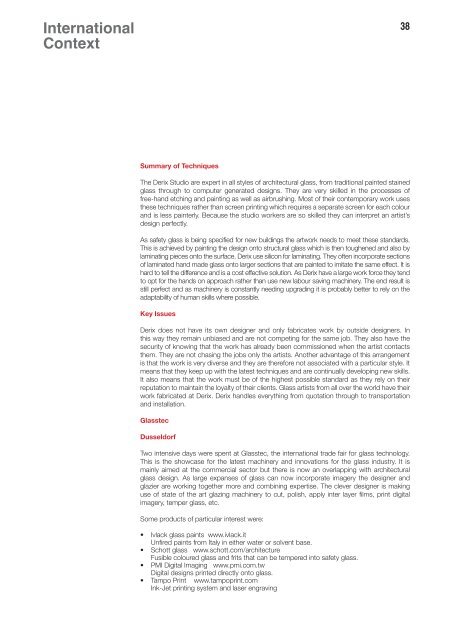contemporary techniques in architectural glass - International ...
contemporary techniques in architectural glass - International ...
contemporary techniques in architectural glass - International ...
You also want an ePaper? Increase the reach of your titles
YUMPU automatically turns print PDFs into web optimized ePapers that Google loves.
<strong>International</strong><br />
Context<br />
38<br />
Summary of Techniques<br />
The Derix Studio are expert <strong>in</strong> all styles of <strong>architectural</strong> <strong>glass</strong>, from traditional pa<strong>in</strong>ted sta<strong>in</strong>ed<br />
<strong>glass</strong> through to computer generated designs. They are very skilled <strong>in</strong> the processes of<br />
free-hand etch<strong>in</strong>g and pa<strong>in</strong>t<strong>in</strong>g as well as airbrush<strong>in</strong>g. Most of their <strong>contemporary</strong> work uses<br />
these <strong>techniques</strong> rather than screen pr<strong>in</strong>t<strong>in</strong>g which requires a separate screen for each colour<br />
and is less pa<strong>in</strong>terly. Because the studio workers are so skilled they can <strong>in</strong>terpret an artist’s<br />
design perfectly.<br />
As safety <strong>glass</strong> is be<strong>in</strong>g specified for new build<strong>in</strong>gs the artwork needs to meet these standards.<br />
This is achieved by pa<strong>in</strong>t<strong>in</strong>g the design onto structural <strong>glass</strong> which is then toughened and also by<br />
lam<strong>in</strong>at<strong>in</strong>g pieces onto the surface. Derix use silicon for lam<strong>in</strong>at<strong>in</strong>g. They often <strong>in</strong>corporate sections<br />
of lam<strong>in</strong>ated hand made <strong>glass</strong> onto larger sections that are pa<strong>in</strong>ted to imitate the same effect. It is<br />
hard to tell the difference and is a cost effective solution. As Derix have a large work force they tend<br />
to opt for the hands on approach rather than use new labour sav<strong>in</strong>g mach<strong>in</strong>ery. The end result is<br />
still perfect and as mach<strong>in</strong>ery is constantly need<strong>in</strong>g upgrad<strong>in</strong>g it is probably better to rely on the<br />
adaptability of human skills where possible.<br />
Key Issues<br />
Derix does not have its own designer and only fabricates work by outside designers. In<br />
this way they rema<strong>in</strong> unbiased and are not compet<strong>in</strong>g for the same job. They also have the<br />
security of know<strong>in</strong>g that the work has already been commissioned when the artist contacts<br />
them. They are not chas<strong>in</strong>g the jobs only the artists. Another advantage of this arrangement<br />
is that the work is very diverse and they are therefore not associated with a particular style. It<br />
means that they keep up with the latest <strong>techniques</strong> and are cont<strong>in</strong>ually develop<strong>in</strong>g new skills.<br />
It also means that the work must be of the highest possible standard as they rely on their<br />
reputation to ma<strong>in</strong>ta<strong>in</strong> the loyalty of their clients. Glass artists from all over the world have their<br />
work fabricated at Derix. Derix handles everyth<strong>in</strong>g from quotation through to transportation<br />
and <strong>in</strong>stallation.<br />
Glasstec<br />
Dusseldorf<br />
Two <strong>in</strong>tensive days were spent at Glasstec, the <strong>in</strong>ternational trade fair for <strong>glass</strong> technology.<br />
This is the showcase for the latest mach<strong>in</strong>ery and <strong>in</strong>novations for the <strong>glass</strong> <strong>in</strong>dustry. It is<br />
ma<strong>in</strong>ly aimed at the commercial sector but there is now an overlapp<strong>in</strong>g with <strong>architectural</strong><br />
<strong>glass</strong> design. As large expanses of <strong>glass</strong> can now <strong>in</strong>corporate imagery the designer and<br />
glazier are work<strong>in</strong>g together more and comb<strong>in</strong><strong>in</strong>g expertise. The clever designer is mak<strong>in</strong>g<br />
use of state of the art glaz<strong>in</strong>g mach<strong>in</strong>ery to cut, polish, apply <strong>in</strong>ter layer films, pr<strong>in</strong>t digital<br />
imagery, temper <strong>glass</strong>, etc.<br />
Some products of particular <strong>in</strong>terest were:<br />
• Ivlack <strong>glass</strong> pa<strong>in</strong>ts www.ivlack.it<br />
Unfired pa<strong>in</strong>ts from Italy <strong>in</strong> either water or solvent base.<br />
• Schott <strong>glass</strong> www.schott.com/architecture<br />
Fusible coloured <strong>glass</strong> and frits that can be tempered <strong>in</strong>to safety <strong>glass</strong>.<br />
• PMI Digital Imag<strong>in</strong>g www.pmi.com.tw<br />
Digital designs pr<strong>in</strong>ted directly onto <strong>glass</strong>.<br />
• Tampo Pr<strong>in</strong>t www.tampopr<strong>in</strong>t.com<br />
Ink-Jet pr<strong>in</strong>t<strong>in</strong>g system and laser engrav<strong>in</strong>g

















